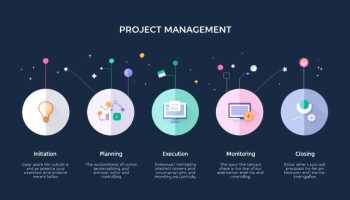
The Five Steps of Project Management
The five steps of project management—initiation, planning, execution, monitoring, and closing—create a clear path for turning ideas into successful project results. Moving through these connected phases lets you define project boundaries, create detailed plans, deliver high-quality work, track performance, and reach your goals.
Key Takeaways:
- Project management success depends on a structured approach that comprehensively addresses each of the five critical steps.
- Thorough project initiation establishes clear objectives, stakeholder expectations, and foundational project parameters.
- Strategic planning creates a detailed roadmap that guides project execution and minimizes potential risks.
- Effective execution requires coordinated resource management, quality control, and adaptive leadership.
- Continuous monitoring and controlling ensure project alignment with original goals and enable timely corrective actions.
Starting with a solid foundation is essential for any project. During the initiation phase, you’ll identify key goals, determine feasibility, and secure stakeholder buy-in. This crucial first step helps avoid scope creep later on and sets clear project boundaries from the beginning.
Planning
Planning transforms your project outline into an actionable strategy. This phase involves creating detailed schedules, allocating resources, and identifying potential risks. A comprehensive plan serves as your project roadmap, guiding decisions throughout implementation.
Execution
During execution, your plan comes to life. This stage focuses on coordinating team members, managing tasks, and ensuring quality standards are met. Effective communication becomes particularly important as you translate plans into deliverables.
Monitoring
The monitoring phase runs parallel to execution. You’ll track progress against your baseline plan, analyze performance metrics, and make necessary adjustments. Performance tracking tools help identify issues early, allowing for prompt corrective action.
Closing
Project closing finalizes your work, documents lessons learned, and releases resources. This often overlooked phase provides valuable insights for future projects and celebrates team accomplishments. Proper closure includes transferring deliverables, collecting feedback, and conducting a post-project review to document successes and areas for improvement.
Each phase builds on the previous one, creating a logical progression that maximizes efficiency and minimizes risk. By following this structured approach, you’ll increase your chances of delivering projects on time, within budget, and to specification.
“Mastering the five steps of project management transforms ambitious visions into actionable realities, ensuring that each stage—from initiation to closing—is meticulously crafted for success. With a structured approach, organizations can navigate challenges, align stakeholder expectations, and achieve their strategic objectives with confidence.”
Project Initiation: Setting the Foundation for Success
Project initiation transforms your abstract ideas into actionable goals with clearly defined parameters. This crucial first step in the five steps of project management lays the groundwork for everything that follows. You’ll need to develop a comprehensive project charter outlining objectives, constraints, timelines, and budget allocations that guide your entire project journey.
A solid business case helps justify your investment through detailed cost-benefit analysis, ensuring stakeholders understand the project’s value proposition. Making informed go/no-go decisions depends on this thorough assessment of feasibility and potential returns.
Identifying and documenting stakeholders in a register is essential for proper engagement throughout the project lifecycle. Their influence, expectations, and communication needs shape your approach to project governance. Once your charter receives approval, conduct a project kickoff meeting to align all participants with the shared vision and objectives.
Key Initiation Activities
The initiation phase determines project feasibility and secures initial approvals through several critical activities:
- Developing a detailed project charter with clear scope boundaries
- Creating a compelling business case with ROI projections
- Identifying and analyzing all stakeholders and their requirements
- Conducting preliminary risk assessments
- Establishing governance structures and decision-making frameworks
- Defining success criteria and key performance indicators
A thorough initiation phase significantly reduces downstream risks and implementation challenges. When you invest time in proper project setup, you’ll find that avoiding common project management mistakes becomes much easier.
The five steps of project management begin with this foundation-setting phase that clarifies what you aim to achieve and why it matters. Your project’s ultimate success often correlates directly with the quality of work done during initiation. By carefully defining parameters before moving forward, you create a reference point against which you’ll measure progress throughout the remaining four steps of the project management process.
Remember that strategic stakeholder identification and management during initiation sets the tone for engagement throughout your project’s lifecycle. When you establish clear channels for communication and feedback early, you’ll foster the collaborative environment necessary for the five steps of project management to unfold successfully.
Projects with a well-structured initiation phase are 40% more likely to meet their original goals and business intent.
hbr.org
Strategic Project Planning: Creating the Project Roadmap
Strategic project planning serves as the blueprint that guides your entire project through the five steps of project management. You’ll find this phase critical for establishing clear direction and preventing costly missteps later on.
When creating your project management plan, you’ll need to incorporate several essential components. Start with defining technical requirements, functional specifications, and key performance indicators (KPIs) that will measure success. Your plan should also include detailed timelines that map out the project schedule from start to finish.
The five steps of project management begin with initiation, followed by planning, execution, monitoring, and closing. During planning, you must select the methodology that best suits your project’s unique characteristics:
- Waterfall – linear approach with sequential phases
- Agile – iterative approach with flexible development cycles
- Hybrid – combining elements of both methodologies
Your planning phase should develop these critical elements:
- Work Breakdown Structure (WBS) – decomposing the project into manageable components
- Resource allocation plan – assigning personnel and materials
- Budget parameters – establishing financial guidelines
- Risk assessment – identifying potential threats and opportunities
- Communication strategy – determining how information will flow
Risk Management Planning
Effective risk management is vital within the five steps of project management. You’ll need to identify potential threats and create appropriate response strategies for each risk. This proactive approach builds project resilience and reduces the impact of unexpected events.
The planning phase directly impacts your ability to control costs and maintain your schedule. By creating a comprehensive roadmap that addresses the five steps of project management, you’ll position your team for success throughout the execution phase. Remember that thorough planning reduces uncertainty and provides clear direction for all stakeholders involved.
Your project planning documents should be living tools that guide decision-making while remaining flexible enough to adapt to changing circumstances. The time invested in creating a solid plan within the five steps of project management framework will yield significant returns through improved efficiency and higher-quality deliverables.

Execution: Transforming Plans into Deliverables
Execution forms the third of the five steps of project management where your carefully crafted plans transform into tangible deliverables. During this critical phase, you’ll coordinate resources, implement processes, and lead your team to produce the project’s intended outputs.
You’ll need to mobilize your team effectively, assigning resources based on your project plan and ensuring everyone understands their responsibilities. Project collaboration techniques become essential as you coordinate workflows and facilitate productive team interactions.
Quality control must be embedded throughout execution, not treated as an afterthought. Implement verification processes that catch issues early before they become costly problems. This phase demands constant vigilance against scope creep through formal change management procedures.
Tools and Techniques for Successful Execution
To streamline your execution phase, leverage these practical tools and techniques:
- Project management software for real-time task tracking and team coordination
- Daily or weekly status meetings to address roadblocks promptly
- Visual management boards to maintain transparency of progress
- Documentation systems to capture decisions and changes
- Resource leveling techniques to optimize team capacity
- Risk response implementation based on your risk response planning
The execution phase requires you to balance adherence to the five steps of project management framework while maintaining flexibility to adapt to changing conditions. Your leadership becomes particularly important as you remove obstacles, facilitate communication, and keep stakeholders informed of progress.
Remember that execution doesn’t happen in isolation—it overlaps with monitoring activities that track progress against baseline plans. The five steps of project management interconnect, with successful execution depending on solid initiation and planning while feeding into effective monitoring and closing processes.
Execution success ultimately depends on your ability to transform theoretical plans into practical action while maintaining quality standards and managing the inevitable changes that occur in any project environment.
Execution is the act of doing and is the most crucial component of successful project management. In fact, studies show that organizations with strong execution capabilities can achieve up to 30% more efficiency in delivering projects.
hbr.org
Monitoring and Controlling: Ensuring Project Alignment
Effective monitoring and controlling is one of the crucial five steps of project management that keeps your project on the right path. This phase runs concurrently with execution, creating a feedback loop that allows you to measure performance against your baseline plan.
You’ll need to implement consistent progress tracking methods to identify potential issues before they become significant problems. Regular status meetings, performance reviews, and milestone tracking help maintain visibility across all project aspects. Critical success factors and key performance indicators provide measurable benchmarks to evaluate project health.
Essential Monitoring Tools and Techniques
The following tools help you maintain control throughout the project lifecycle:
- Earned Value Analysis – Measures cost and schedule performance against planned values
- Variance Reports – Identifies deviations from baselines in scope, schedule, and budget
- Quality Control Checks – Ensures deliverables meet established standards
- Risk Reassessments – Updates risk registers as new threats or opportunities emerge
- Change Control Systems – Manages scope modifications through formal processes
Implementing a robust project communication strategy is vital during this phase. Stakeholders need regular updates on progress, challenges, and any corrective actions taken. When issues arise, you must take prompt action through intervention strategies like resource reallocation or schedule adjustments.
Remember that the five steps of project management work together as an integrated system. Your monitoring efforts directly inform the controlling actions you’ll take. For instance, if performance metrics show schedule slippage, you might fast-track certain activities or implement project crashing techniques to recover lost time.
This table summarizes the key components of effective monitoring and controlling:
| Component | Purpose | Example Tools |
|---|---|---|
| Performance Tracking | Measure progress against baselines | Dashboards, S-curves, Milestone charts |
| Variance Analysis | Identify and address deviations | Variance reports, Trend analysis |
| Quality Management | Ensure deliverables meet requirements | Quality audits, Testing, Inspections |
| Risk Monitoring | Track identified risks and identify new ones | Risk reassessment, Risk audits |
| Change Control | Manage scope modifications | Change request forms, Impact assessments |
The monitoring and controlling phase within the five steps of project management provides the oversight needed to keep your project aligned with objectives. When done effectively, it enables early problem detection and intervention, ultimately improving your chances of project success.
Expert Insight: **Professional Tip:** To ensure project alignment during the monitoring and controlling phase, establish a structured approach to track performance against your baseline plan. Utilize essential tools like Earned Value Analysis and Variance Reports to identify discrepancies early, allowing for timely interventions. Regular communication with stakeholders about progress and challenges reinforces transparency and fosters collective problem-solving, enhancing overall project success.






